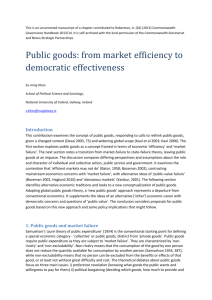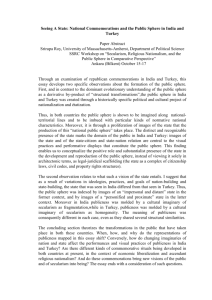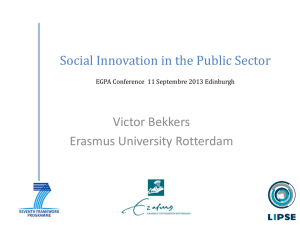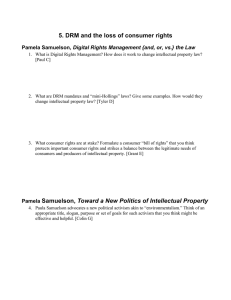Working Paper SAMUELSON MACHINES AND THE OPTIMAL PUBLIC-PRIVATE MIX
advertisement
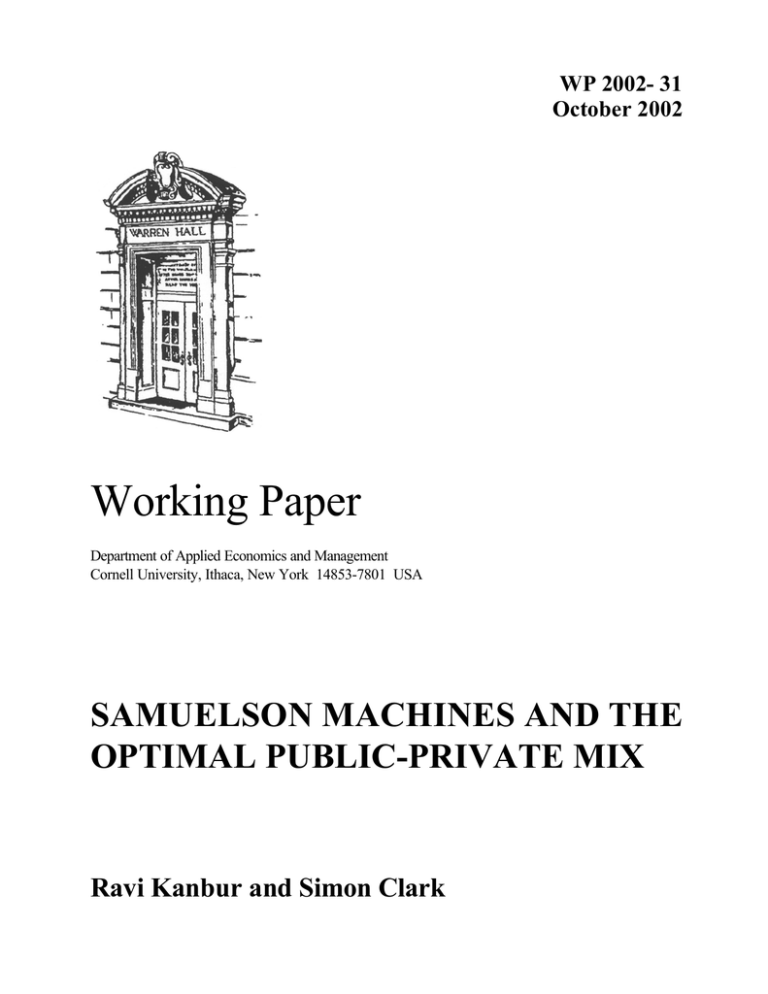
WP 2002- 31 October 2002 Working Paper Department of Applied Economics and Management Cornell University, Ithaca, New York 14853-7801 USA SAMUELSON MACHINES AND THE OPTIMAL PUBLIC-PRIVATE MIX Ravi Kanbur and Simon Clark It is the Policy of Cornell University actively to support equality of educational and employment opportunity. No person shall be denied admission to any educational program or activity or be denied employment on the basis of any legally prohibited discrimination involving, but not limited to, such factors as race, color, creed, religion, national or ethnic origin, sex, age or handicap. The University is committed to the maintenance of affirmative action programs which will assure the continuation of such equality of opportunity. Samuelson Machines and the Optimal Public-Private Mix Ravi Kanbur Simon Clark Cornell University Edinburgh University sk145@cornell.edu simon.clark@ed.ac.uk October 2002 Abstract Standard economic analysis assumes the sets of public and private goods to be exogenously given. Yet societies very often choose the public-private mix, using resources to convert seemingly private goods into ones with public goods characteristics and vice versa. And, in practice, we see a bewilderingly large variety of public-private mixes across societies. This papers advances an analysis of the choice of the public-private mix in the framework of voluntary contributions to public goods provision, by envisaging that, starting from a situation where all goods have private characteristics, some goods can be changed to have public goods characteristics at a cost (by purchasing a “Samuelson machine”). It characterizes the jointly optimal choice of the public-private mix and the efficient supply or not of the public goods in the mix. This characterization generates a number of testable predictions on the public-private mix, and on the prevalence of free riding. Keywords: Public goods; public-private mix; Samuelson machine; cost of publicness. JEL Classification: D11; D61; H41. 1 1 Introduction In standard public economics, the division between private goods and public goods is taken as given and immutable. It is assumed that some goods simply have the technological feature that their consumption is non-rival and non-excludable. Following Samuelson’s (1954) classic exposition, the set of (pure) public goods and the set of private goods are part of the exogenous specification of the model. The analysis then proceeds from this division to ask questions about such matters as efficient supply, decentralization, and free rider problems. Yet in the real world such a neat exogenous division is not observed. Whether the consumption of a good is in fact non-rival and non-excludable is often a social or historical construct rather than given by technology. For example, defence expenditure is often cited as a typical example of a public good: to defend a county, or to deter an attack on it, is to protect all the inhabitants of the country. But national defence is a public good because of the artefact of the nation state, one of whose basic functions is to maintain the integrity of its territory. Before the re-unification of Germany in 1991 an attack on West Germany was not an attack on East Germany. Now it is, and the inhabitants of the former East Germany benefit from defence expenditure by the inhabitants of what was West Germany, and vice versa. Thus a population occupying a given territory, for example the area between the Rhine and Oder rivers, can in principle be one in which defence effort benefits only those individuals or communities who incur the cost, rather than the entire popula- 2 tion. Who benefits from whose defence expenditure , i.e. the degree of ’publicness’ of defence, depends on the political constitution of the territory. If it comprises a collection of city states and principalities (which is how one might characterise both Germany and Italy before their respective unifications in the nineteenth century) then a large army in, say, Schleswig-Holstein or Lombardy will not deter aggression against Bavaria or Tuscany. But in a united Germany or Italy, such aggression would be deterred. Similarly, at the international level, signing defence treaties or setting up organisations such as NATO whose central principal is that ’an attack on one is an attack on all’ further extends the benefits of defence expenditure. This is embodied in the notion of ’collective security’. The evolution of defence arrangements at the local, national, and international level is presumably partly a matter of choice for the individuals and countries concerned. When they make this choice they convert a previously private good to one which now has public goods properties of non-rivalry and non-excludability. Conversely, when societies collapse into anarchy and civil war, as has been happening in many countries in Africa, or when they are partitioned, as with Germany in 1945 or India in 1947, the process goes in the reverse direction. A second example concerns the dissemination of information and signals. For instance, television programmes, once produced, are in principle available to everyone: there is no need to produce another programme or to hire additional actors or TV presenters if more people are to view the programme. But in order for viewers not to be excluded from seeing the programme they must be able to receive the TV signal. 3 This requires some form of network: either a transmitter able to produce a strong signal, or a network of transmitters that can relay a signal across long distances, or a cable network connecting the viewer to the TV company, or a satellite to relay the signal. The network acts a platform, without which the TV programme is a private good, rather like a private theatre performance. With the network in place, the marginal cost of including further viewers is essentially minimal. Thus the network has the potential to transform a private good into a public good. Of course, some forms of network do allow viewers to be excluded via devices such as satellite decoders; the cable company can cut off your signal if you do not pay. But ’free-to-air’ signals via conventional terrestial TV transmitters do not allow this. What we observe in practice, then, is that every society that has access to a dissemination technology has the opportunity to build a platform and to make TV signals a non-rivalrous and nonexcludable public good. Some societies choose to avail themselves of this opportunity; others do not. Whether the good is private or public, then, is not exogenously given but socially determined. More generally, the “public-private mix” varies considerably across societies. By this we mean not only the straightforward point that the share of public expenditure in GDP varies across societies. Rather, the more telling observation is that the composition of goods that are supplied through collective action varies greatly across societies, even correcting for the share of the government in national income. For example, higher education is in the collective domain to varying degrees across countries. In some countries, the national infrastructure for higher education is accessible 4 to all, with very little private supply, whereas in other countries there is very little in the way of collective supply of this level of education. At a more local level, provision of services such as garbage collection or security also demonstrates a broad spectrum between collective and private provision. In some areas the good (service) of garbage disposal is individualized, while in other areas it is a collective enterprise to which the whole community contributes. In poor village economies, there is equally a wide variation in the degree to which irrigation is individualized or collectivized. Even when a good is supplied through collective action rather than privately, the free rider problem is solved to different degrees in different situations (Ostrom, 1990), leading to yet more variations in observed patterns for the supply of the same good. The general point we wish to make is that while there may be some cases where technology is destiny, in a large number of cases societies can indeed choose whether a good is “private” (i.e. rivalrous and excludable in consumption) or “public” (i.e. non-rivalrous and non-excludable). We wish to develop framework in which we can think systematically about such choices and to delineate the costs and benefits of one form of social organization over another. This will also allows to begin to identify the factors that determine the public-private mix in the sense intended here, and thus to explain the variations we observe in practice. To fix ideas, consider the standard model of voluntary contributions to public goods, as systematized for example by Bergstrom, Blume and Varian (1986). In this model the private good has the property that an individual’s expenditure on the good only benefits that individual. However, for public goods each individual’s 5 expenditure benefits all individuals. In the most commonly used formulation, each individual benefits from the sum of all individuals’ contributions. For example, if there are two individuals and each contributes ten dollars, then each will in turn enjoy twenty dollars worth of the public good. In other words, a machine for turning ten dollar bills into twenty dollar bills! Such “Samuelson machines” clearly convey a benefit relative to the alternative of autarchy. If goods could be costlessly converted from private to public, then in this case of positive externalities a society would want to have all its good public. Notice that this would be the case whether or not there was free riding in the supply of the public good. It is better to eliminate free riding than not, if it can be done costlessly, but society would be better off in either case. What is important is that the conversion provides a platform for positive externalities, which are beneficial relative to autarchy whether or not they are ultimately internalized through further collective action. In other words, in the context of the voluntary contributions to public goods model we envisage three scenarios for a typical good. One scenario is simply that the good in question is private. The second scenario is that the good is public but that the contributions are determined as the equilibrium of a Nash contributions game. The third scenario is that the good is public but the contributions are determined so as to maximize joint welfare–the efficient outcome. The value of converting from private to public thus depends on what sort of collective action takes place after the conversion. But in each case there is a prior collective act. This is the act of converting the good from private to public–effectively, putting in place a Samuelson machine where none 6 existed before. Suppose now that the institutional arrangements that need to be put into place to generate positive externalities where there were none before are costly–treaties need to be agreed on and signed for defence, joint arrangements for garbage disposal need to be put into place, a common curriculum needs to be developed for schools, etc. In other words, Samuelson machines are costly. How much would society be willing to pay to get one if it didn’t already have one? If it already had m such machines, how much would it be willing to pay for an additional (m + 1)th machine? Of course the answer depends on whether or not society will be able to enforce an efficient outcome once the machine is bought. But suppose now that achieving efficiency is itself costly. The institutional arrangements for monitoring and sanctioning free riding do not come free. However, the value of curbing free riding will itself not be independent of the number of Samuelson machines in play. Our society then faces two simultaneous interdependent problems–whether or not to curb free riding, and how many Samuelson machines to buy. It is this joint solution that the paper develops and interprets in the sections to come. Section 2 presents the basic model–we develop the simplest possible setting in which our basic points can be made cleanly and tractably. Section 3 considers the value of Samuelson machines with and without free riding, and the optimal publicprivate mix in each setting. Section 4 analyses the joint decision on public-private mix and whether or not to control free riding. Section 5 concludes the paper with a discussion and interpretation of the key results. 7 2 Samuelson Machines We will keep the basic model very simple to aid in sharpness for results and intuition. Essentially, it is the log-linear version of the standard model of private contributions to public goods (Bergstrom, Blume and Varian, 1986). There are n goods in all, indexed j = 1, 2, . . . , n. In general, let m of these goods be public and n − m goods be private. A public good has the standard properties of non-excludability and non-rivalry in consumption. Denote the set of public goods by P. There are two individuals, each with identical lump sum income y. All prices are normalized at unity. Individual i spends xij on good j, so the budget constraint is given by P xij = y ; i = 1, 2 (1) j Let the consumption of good j by individual i be denoted cij . Then /P cij = xij for j ∈ (2) cij = c∼ij = cj = xij + x˜ij for j ∈ P (3) where ∼ i denotes the individual other than i. Thus, for a public good, each individual enjoys consumption of the sum of all expenditures on the good. Utility of individual i from consumption is given by Ui = P j αj log cij ; αj > 0 ∀j ; 8 P j αj = 1, (4) where log denotes the natural logarithm. In other words, we assume that preferences are log linear with parameters αj . Using (2) and (3), the utility function in (4) and the budget constraint in (1) can be rewritten as Ui = P αj log cij + j ∈P / αj log cj ; i = 1, 2 (5) j∈P j ∈P / P P cij + P cj = y + j∈P P x˜ij ; i = 1, 2 (6) j∈P Thus, for each individual it is as though there were an increase in lump sum income equal to the contributions of the other individual to public goods. We start by considering the Nash equilibrium in contributions to the public good. Each individual maximizes (5) subject to (6) i.e. taking as given the other’s expenditure on public goods. Using (2) and (3) the first order conditions can be written as · ¸ P xij = αj y + /P x˜ik ; j ∈ (7) k∈P xij + x˜ij · ¸ P = αj y + x˜ik ; j ∈ P (8) k∈P The solution can be approached using the fact that in this society of identical individuals, equilibrium will be symmetric, so that xij = x˜ij = xj . Equation (8) can then be rewritten as 2xN j = · ¸ P N αj y + xk y ; j ∈ P (9) k∈P where the superscript N denotes the Nash equilibrium outcome. The equations in (9) have as solution: xN j · ¸ αj = y ; j∈P 2−β 9 (10) where β = P k∈P αk . Using this in (3), equation (7) gives the consumption levels of all goods for the (identical) individuals: cN j =αj · ¸ 2 y for all j 2−β (11) Substituting back into the utility function gives us Nash equilibrium utility for each individual as follows: V N = K + log y + log 2 (2 − β) (12) where K= n P αj log αj (13) j=1 V 0 = K+ log y can be thought of as an individual’s autarchy utility, the level that can be achieved if he/she is unable to take advantage of the other’s provision of public goods. As is well known, the Nash equilibrium is inefficient. The efficient allocation is derived as the solution to max n P αj logc1j + j=1 s.t. P n P αj logc2j j=1 (c1j + c2j ) + P cj = 2y (14) j∈P j ∈P / The common consumption levels and utility are thus given by cE /P j = αj y ; j ∈ (15) cE j = 2αj y ; j ∈ P (16) 10 and V E = K + log y + β log 2 (17) where the superscript E denotes the socially efficient outcome. It can be seen directly from (10) and (13) that utility in both N and E depends on the set of goods that are public. In particular, given the parameters α1 , ..., αn , both V N and V E increase with β = P j∈P αj . This is shown in Figure 1, where V 0 = K+ log y (which does not depend on β ) is set equal to 0. As expected, when β = 0 (i.e. when all goods are private), there can be no free riding in the Nash Equilibrium and V N = V E = V 0 . The possibility of free riding arises when β > 0, and indeed for 0 < β < 1, V 0 < V N < V E . But surprisingly, V N = V E when β = 1. At first, this seems very counter-intuitive, as one might expect that the more public goods there are, the greater the welfare loss from free riding in the Nash Equilibrium. But free riding operates when agents under-supply public goods and consume more private goods; in other words, free riding needs a public good/private good margin at which to operate. If β = 1 this margin does not exist; and even if β is close to 1, then private goods carry little weight in agents’ utility functions, so the incentive to free ride is very low. The efficiency loss V E − V N thus depends both on the opportunity for free riding, which requires a high level of β, and the incentive to free ride, which requires a low level of β. For extreme values of β, one of the requirements is absent. In our model, it is easily checked that V E − V N is greatest when β = 2 − log1 2 = 0.557. When consumers have identical preferences, the result that the efficiency loss is zero 11 if there are only public goods is quite general, since all consumers will choose their private supply of public goods to maximise the same utility function u(c1 , c2 , ...cn ), where j ∈ P for j = 1, ...n. With identical tastes and no private goods, all agents’ private incentives are perfectly aligned towards maximising a common objective. This completes the setting up of the basic model. The next section takes up the task of analyzing outcomes when the set of public goods, P , is itself a choice variable. 3 The Public-Private Mix With and Without Efficient Supply If this society had a costless choice, it would always opt for increasing β. It does not matter through what combinations of public goods β is increased - all sets P for which β is the same are identical from the point of view of social welfare. Given this, we focus on β as the key choice variable, and characterize the cost of public goods technology as the cost of increasing β. Moreover, for analytical ease we work with the approximation that there are a large number of goods and treat β as a continuous variable. Let us suppose that society could “purchase” β at a unit cost (in terms of endowment) of 2θ . In other words, the per capita marginal cost of converting a private goods technology into a public goods technology is θ . Then utility in N and in E is given by V N = K + log (y − θβ) + log 2 (2 − β) V E = K + log (y − θβ) + β log 2 12 (18) (19) As in the previous section V N = V E if β equals zero or one and V N < V E for intermediate values. There is thus an obvious sense in which, as a function of β, V N is “more convex” than V E . As a consequence, the optimal choice of β is more sensitive to θ in state N than in E. bN and β bE , and the achieved Formally, the optimal choices of β in the two cases, β utility levels Vb N and Vb E as functions of θ and y are given by: N b = 1; β Vb N = K + log (y − θ) + log 2 if bN = 0; β Vb N = K + log y bN ∈ (0, 1) ; V N = K + log y β and E b = 1; β bE = β y θ − 1 ; log 2 bE = 0; β if θ y θ y if Vb E = K + log(y − θ) + log 2 if V E = K + log y if Vb E = K + log θ + yθ log 2 − log log 2 − 1 if 1 2 ≤ = θ y θ y 1 2 (20) 1 ≥ 2. ≤ log 2 1+log 2 log 2 1+log 2 θ y ≤ θ y ≤ log 2 ≥ log 2. (21) The optimal choices of “the degree of publicness” for N and E are shown in Figure 2 as a function of yθ , the unit cost of β as a fraction of the endowment. For sufficiently low costs, ( yθ < high costs ( log 2 ), 1+log 2 θ y all goods are chosen as public in both N and E. For sufficiently > log 2), all goods are private in N and E. For intermediate values of cost, interesting differences appear. As acquiring public goods, but for θ y θ y falls below log 2, E is the first to start above 0.5 N stays completely private. At switches to completely public and stays that way. As bE = 1 at increasingly public until β θ y = log 2 1+log 2 13 . θ y θ y = 0.5 N continues to fall, E becomes The Jointly Optimal Choice of Efficiency (or Not) and the 4 Degree of Publicness If obtaining the efficient equilibrium were costless, then society would always be in E, with the choice of β depending on yθ , as shown in Figure 2. However, efficiency itself is not free. It requires the setting up and operation of costly institutions. In what follows we relate these costs to the choice of E versus N, taking into account the optimal choice of β in each case. We adopt the simple assumption that there is a fixed per capita cost π of achieving bN and Vb N are still given by (20) but in E the maximand is now efficiency. β V E = K + log (y − π − θβ) + β log 2 (22) bE and Vb E in (21), y is now replaced by y − π, i.e. so that in the expressions for β E b = 1; β bE = β y−π θ bE = 0; β − 1 ; log 2 Vb E = K + log(y − π − θ) + log 2 if y−π θ log 2 − log log 2 − 1 if V E = K + log(y − π) if Vb E = K + log θ + θ y−π ≤ log 2 1+log 2 θ y−π log 2 1+log 2 ≤ θ y−π ≤ log 2 ≥ log 2. (23) Thus, conditional on society choosing E rather than N, higher values of π result bE . In state E, an increase in π is equivalent to a reduction in lower values of β in y, and given the diminishing marginal utility of income embodied in the term log (y − π − θβ) the appropriate response is to offset the loss of income by a reduction in θβ i.e. to economise on resources by choosing a lower level of publicness. It is now straightforward to analyse the choice of E versus N. For any given values 14 of π, θ, and y, the higher of Vb E and Vb N indicates whether or not it is worth putting in place those institutions which enable society to overcome free-rider problems and bE or achieve efficiency. An equiproportional increase in π, θ, and y has no effect on β bN , or on the difference Vb E − Vb N , and Figure 3 shows the optimal regime, E or N, β as a function of π y θ y and To interpret Figure 3, recall a result of Section 3, shown in Figure 2, that in regime E (and with π/y implicitly equal to zero) it is optimal to choose an intermediate degree of publicness if to zero at θ y log 2 1+log 2 < θ y < log 2, whereas in regime N β N switches from one = 0.5. But since V E ≥ V N , with equality if and only if β equals zero or one, it follows that V E > V N if range of θ y log 2 1+log 2 < θ y < log 2. For positive values of πy , the for which it is optimal to choose E over N becomes narrower. If enough (greater than 1 2 π y is high log 2 − 1+log = 0.043) then the costs of efficiency are too great, 2 log 2 whatever the cost of using the Samuelson machine to convert private to public goods. Figure 3 thus divides ( πy , yθ ) space into three regions: (i) an area where it is optimal to choose N and set β N = 1. Here either the costs of efficiency are too great or the costs of publicness are so low that a Nash regime can avoid any loss of welfare from free-riding by making all goods public; (ii) an area where it is optimal to choose N and set β N = 0. In this region either the costs of publicness are so high that both regimes would set β = 0 (so that for π > 0 choosing E would only incur additional costs), or for θ y just above 0.5 the gain from choosing positive levels of publicness under E would not offset the additional cost of efficiency; (iii) an area where it is 15 optimal to choose E. Here the level of β E is given by bE = β 5 1− π y θ y − 1 . log 2 (24) Discussion and Conclusion We started with the observation that societies seem to have a bewildering variety of public-private mixes. Yet the basic framework in public economics is one where the division of the space of goods into public and private is given exogenously as a technological datum. Thus in this framework it is simply the technologically determined set of public goods that varies across societies and determines variations in the public private mix. This is unsatisfactory theoretically, and implausible as a depiction of reality, since we know that societies can and do choose to make the consumption characteristics of a good as “public” or as “private” as they wish to. Many such example were given in the introduction. The central question in the literature on inefficient supply of the public good does not of course disappear in the broader framework of choice of the set of public goods. Rather, the two aspects interact in interesting and intriguing ways. The choice of the set of public goods is not independent of whether or not the collective action problems will be solved for these goods; and whether or not it is worth paying the cost of solving collective action problems is itself not independent of the set of public goods. Figure 3 characterizes the jointly optimal choice of the degree of publicness and the degree of efficiency in the supply of public goods, as a function of the two 16 basic cost parameters–the cost of converting private goods into public goods (or the price of “Samuelson machines”), and the cost of enforcing the efficient collective action outcome on the supply of public goods. Figure 3 allows us an entry point into understanding the different choices that societies might make, and why. Fairly clearly, when the cost of turning private goods into public is high enough, the society will go for a very low degree of publicness. In contrast, when this cost is low enough, it will go for a very high degree of publicness. Frontier societies with physical barriers to creating a common platform for positive externalities will opt for low publicness in their public-private mix. More generally, a specific hypothesis that flows from this analysis is that population density is a determinant of the degree of publicness. Notice, however, that for both high enough and low enough costs of publicness, it is not worthwhile to pay the costs of solving collective action problems. This is because the margin at which free riding induces inefficiency is non-existent when all goods are public or all goods are private, and when the degree of publicness is small enough or large enough, the costs of free riding are correspondingly small relative to the costs of enforcing collective action. Paradoxically, therefore, observing free riding in the supply of public goods does not necessarily indicate social inefficiency, once the costs of the “efficient” outcome are taken into account. However, a specific hypothesis that emerges from our analysis is that we will observe a Nash equilibrium in the supply of public goods in societies with both very high and very low degrees of publicness. 17 For intermediate values of the cost of publicness, and for low enough costs of efficiency, we predict that society will choose efficient supply of the public goods it chooses to produce, this degree of publicness being given by (24). In this range the degree of publicness will decline with the cost of efficiency and the cost of publicness. This scenario perhaps comes closest to economists’ basic intuitions on explaining the variation in the degree of publicness. As the cost of free riding increases, the value of public goods declines, and it is not worth paying the price of the marginal Samuelson machine–the degree of publicness falls. Finally, consider what happens as societies become richer. Of course, if the cost of efficiency and the cost of publicness rise in proportion, nothing is changed in Figure 3. But suppose now, at one extreme, that these costs remain constant. Then essentially the outcome moves inwards along a ray to the origin in Figure 3. The most variegated pattern occurs when the ray crosses the Efficient region depicted in Figure 3. Then, for low levels of income, the outcome is one of zero degree of publicness. As income increases we move into a region of increasing publicness and efficient supply of the public goods. But finally, at high level of incomes, the degree of publicness becomes extreme and we observe free riding in the supply of the public good. Thus the prediction is that as income increases the degree of publicness rises, but that the likelihood of Nash equilibrium has an inverse-U shape–it is highest in both very rich and very poor societies. We hope that the line of enquiry begun here will prove fruitful in opening up the black box of an assumed given set of public goods. A direct consideration of how 18 and why societies choose to convert some private goods into public ones, and vice versa, generates both interesting theory, and interesting predictions and hypotheses for empirical work. References Bergstrom, T.C., L. Blume, and H. Varian (1986). “On the Private Provision of Public Goods.” Journal of Public Economics, 29, 25-49. Ostrom, Elinor (1990). Governing the Commons: The Evolution of Institutions for Collective Action. New York: Cambridge University Press. Samuelson, Paul A. (1954). “The Pure Theory of Public Expenditures.” The Review of Economics and Statistics, 36, 387-389. 19 Figure 1: The effect on V N and V E of changes in β 20 Figure 2: The effect on β N and β E of changes in θ 21 Figure 3: Choice of regime 22 OTHER A.E.M. WORKING PAPERS WP No Title Fee Author(s) (if applicable) 2002-30 An Incentive Compatible Self-Compliant Pollution Policy under Asymmetric Information on Both Risk Attitudes and Technology Peterson, J. M. and R. N. Boisvert 2002-29 Market Efficiency, Competition, and Communication in Electric Power Markets: Experimental Results Chapman, D., C.A. Vossler, T.D. Mount, V. Barboni, R.J. Thomas and R.D. Zimmerman 2002-28 The Shadow Economy in Post-Soviet Tajikistan S. Kyle 2002-27 Are Joint Ventures with Local Firms an Efficient Way to Enter a Culturally Distant Market? The Case of Japanese Entry into the United States J. F. Francois, T. Roehl, and J. M. Hagen 2002-26 Causes and Consequences of Food Retailing Innovation in Developing Countries: Supermarkets in Vietnam Hagen, J. M. 2002-25 Management of National Parks in Developing Countries: A Proposal for an International Park Service Chapman, D. 2002-24 Subsidized Vehicle Acquisition and Earned Income in the Transition from Welfare to Work M. T. Lucas and C. F. Nicholson 2002-23 Effects of Food and Health Spending Patterns on the Health of the Elderly Gómez, M. and C. K. Ranney 2002-22 Do Healthier Diets Cost More? Ranney, C. K. and P. E. McNamara 2002-21 Population Growth and Poverty Measurement Chakravarty, S. R., R. Kanbur and D. Mukherjee 2002-20 Achieving Efficiency and Equity in Irrigation Management: An Optimization Model of the El Angel Watershed, Carchi, Ecuador Evans, E. M., D. R. Lee, R. N. Boisvert, B. Arce, and T. S. Steenhuis 2002-19 The Andean Price Band System: Effects on Prices, Protection and Producer Welfare Villoria, N. and D. R. Lee 2002-18 Education, Empowerment, and Gender Inequalities Kanbur, R. 2002-17 IFI's and IPG's: Operational Implications for the World Bank Kanbur, R. 2002-16 How Workers Get Poor Because Capitalists Get Rich: A General Equilibrium Model of Labor Supply, Comunity, and the Class Distribution of Income Dasgupta, I. and R. Kanbur Paper copies are being replaced by electronic Portable Document Files (PDFs). To request PDFs of AEM publications, write to (be sure to include your e-mail address): Publications, Department of Applied Economics and Management, Warren Hall, Cornell University, Ithaca, NY 14853-7801. If a fee is indicated, please include a check or money order made payable to Cornell University for the amount of your purchase. Visit our Web site (http://aem.cornell.edu/research/wp.htm) for a more complete list of recent bulletins.
